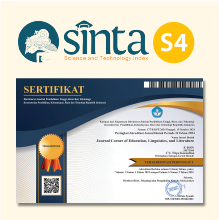Improving Students’ Vocabulary Mastery Through the Keyword Technique At The Tenth Grade of SMAN 2 Tulang Bawang Tengah
 https://doi.org/10.54012/jcell.v1i2.28
https://doi.org/10.54012/jcell.v1i2.28
 Abstract views: 2434
Abstract views: 2434
 PDF downloads: 790
PDF downloads: 790
Keywords:
Action Research, Keyword Technique, Vocabulary Mastery.Abstract
The aim of this research was to improve students’ vocabulary mastery of the tenth grade through the use of Keyword technique. This research is categorized as classroom action research. The subject of this research was the tenth grade students of SMAN 2 Tulang Bawang Tengah in the academic year of 2021/2022. The data were analyzed by using descriptive statistics and quantitative data analyses. This research was conducted in two cycles where each cycle consisted of three meetings. Based on the analysis of the research findings, the students’ vocabulary mastery was improved by using Keyword technique based on the quantitative and qualitative data. From quantitative data, the result showed that the mean score of each cycle was increased from post-test of cycle 1 to cycle 2. The mean score of cycle 1 was 62.07, there were 13 students or 46.43% who passed Minimum Mastery Criterion, while in cycle 2 was 77.93, there were 21 students or 75% who passed Minimum Mastery Criterion. Moreover, this improvement can also be seen from qualitative data, such as the results of students’ observation sheet from cycle 1 to cycle 2. The mean score of cycle 1 was 6.41, while in cycle 2 was 7.31. The improvement of students’ learning activity from cycle 1 to cycle 2 was 0.90. It showed that the students seemed to be more motivated and confidence in learning vocabulary. Therefore, it can be concluded that the implementation of the Keyword technique can improve students’ learning activities and vocabulary mastery.
Downloads
References
Agoestyowaty, Redjeki. (2010). Fun English Games and Activities for You. Jakarta: PT Buana Ilmu Populer.
Burns, A. (2010). Doing Action Research in English Language Teaching. Madison Ave, New York: The Guilford Press.
Cameron, Lynne. (2001). Teaching Language to Young Learners. Cambridge: University Press.
Creswell, J. (2014). Research design: Qualitative, Quantitative, and Mixed Methods Approaches (V. Knight (ed.); Fourth Edi). SAGE Publication. https://doi.org/10.4135/9781849208956
Damiri, A. (2019). The Influence of Text Twist Game towards Students’ Vocabulary Mastery at the First Semester of The Tenth Class at SMA ADIGUNA Bandar Lampung in 2012/2013. Lentera: Jurnal Ilmiah Kependidikan, 1, 36-53.
Elfrieda H. Hiebert and Michael L. Kamil, (2005), Teaching and Learning Vocabulary: Bringing Research to Practice, USA: Lawrence Erlbaum Associates, Inc.
Foster, J. K. (2009). Memory: A Very Short Introduction. New York: Oxford University Press.
Hayes, O.C. (2009). The Use of Melodic and Rhythmic Mnemonics to Improve Memory and Recall in Elementary Students in the Content Areas. Publish Thesis. Dominican University of California.
Irawati, L. (2008). LEARNING STRATEGIES USED BY DIFFERENT GENDER IN SPEAKING CLASS OF IKIP PGRI MADIUN. Sebelas Maret University.
Jondeya, R. S. (2011). The Effectiveness of Using Information Gap on Developing Speaking Skills for the Eighth Graders in Gaza Governorate Schools.
Ketabi, Saeed and Amiryousefi Mohammad. (2011). Mnemonic Instruction: A Way to Boost Vocabulary Learning and Recall. Journal of Language Teaching and Research vol 2 No 1 Issue January 2011.
Larsson, K. (2017). Understanding and teaching critical thinking—A new approach. International Journal of Educational Research, 84(June), 32–42. https://doi.org/10.1016/j.ijer.2017.05.004
Mardiana, L. (2012). Vocabulary Teaching Strategies Used by Teachers of Junior High School. Unpublished Bachelor Thesis. Purwokerto: Muhammadiyah University of Purwokerto.
Murcia, M.C (2001). Teaching English as a Second of Foreign Language. University of California: California.
Nasrollahi, M. A., Krishnasamy, P. K. N., & Noor, N. M. (2015). Process of implementing critical reading strategies in an Iranian EFL classroom: An action research. International Education Studies, 8(1), 9–16. https://doi.org/10.5539/ies.v8n1p9
Richard and Rodgers. (2001). Approaches and Methods in Language Teaching. New York. Cambridge University Press.
Smith, J. R. (1978). Teaching for cross cultural understanding. 285.
Thornbury. (2012). How to Teach Vocabulary. England. Pearson Education Limited.
Tomal, Daniel R. (2003). Action Research for Educators. Oxford: The Scarrow Press.
Widiati, U., & Cahyono, B. Y. (2006). The Teaching of EFL Speaking In the Indonesian Context: The State of the Art. Bahasa Dan Seni, 34(2), 269–292. https://doi.org/10.15639/TEFLINJOURNAL.V19I1/1-17
Wood, J. C. M. (2008). The Impact of Globalization on Education Reform: A Case Study of Uganda. 409. https://doi.org/10.1007/978-3-319-01125-7_4
Yasuyo Matsumoto. (2008). Investigating classroom dynamics in Japanese university EFL classrooms [The University of Birmingham]. In A thesis Doctor of Philosophy (Issue September). http://etheses.bham.ac.uk/296/
Downloads
Published
How to Cite
Issue
Section
License
Copyright (c) 2021 Eva Nurchurifiani, Rizki Novia Nissa, Febriyanti

This work is licensed under a Creative Commons Attribution-ShareAlike 4.0 International License.
All articles published in the Journal Corner of Education, Linguistics, and Literature are licensed under the Creative Commons Attribution-ShareAlike License (CC BY-SA).















